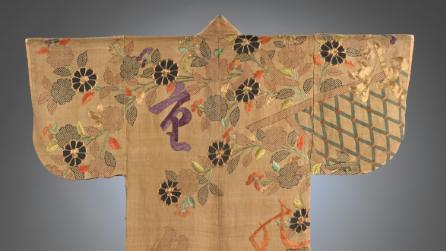The Japanese gown uniting Freddie Mercury, the Jedi and Bjork

A kimono from the 17th century which is on display at the museum
- Published
Freddie Mercury adored them and collected them as he travelled across Japan on tour.
George Lucas put them at the heart of every costume in the Star Wars franchise and they were the favoured backstage dress of Boy George and David Bowie.
Now, a collection of Kimono owned by some of entertainment’s most influential personalities has gone on display at an exhibition in Dundee.
Kimono: Kyoto to Catwalk charts the history of the traditional Japanese dress from its far east origins to the garment’s place in contemporary fashion.
- Published19 January
- Published15 September 2023
- Published30 March
More than 300 artefacts, including a collection of the gowns owned and worn by the Queen front man, are featured in the showcase at the V&A until January.
The show, which originally opened in London in January, shines a light on their cultural impact in the West – including those in a galaxy far, far away.
“You see kimono as being distinctly Japanese, but they also have this universal timeless quality,” said Anna Jackson, curator of the exhibition, external.
“George Lucas was very much inspired by the films of Kurosawa, and at one point it’s believed he considered offering the role of Obi Wan Kenobi to the veteran actor Toshiro Mifune who appeared in Sanjuro.
“Mifune didn’t speak English and didn’t think it appropriate so the part went to Alec Guinness but the costumes, part Samurai and part Buddhist monk were inspired by the simple shape of the kimono and I believe the actors referred to them as that, so they knew exactly what they were wearing.”
Freddie Mercury was an avid collector of Kimono during Queen's tours of Japan
Mifune’s Jedi-inspiring stage costume and Mercury’s favourite cherry blossom gown are among the exhibits on display.
The show has been expanded since its London outing for the final stop on its tour.
One of the additions is the oldest surviving Japanese robe in the UK. It belonged to Sir James Dalrymple who added his own family crest to the design, and like many writers and politicians, used his kimono as a house coat or dressing gown when entertaining guests at his home in Newhailes House in Musselburgh in the early 18th century.
“It was made in Japan, came to the Netherlands and ended up in Scotland, so it speaks to this amazing cross-cultural connection between Japan and Scotland which stretched back centuries,” said Kirsty Hassard, V&A Dundee curator.
A kimono worn by Mercury is on display as part of the exhibition
Another kimono from the 1920s features a distinctive rose and lattice pattern which echoes the work of Charles Rennie Mackintosh.
“We know Mackintosh didn’t visit Japan but was hugely inspired by what he saw in books,” says Kirsty.
“And we think these designers were doing the same, on the other side of the world.”
Ms Jackson believes the versatility of kimono is what makes it so enduring. It can be adapted to any shape or size and worn by men or women.
In the late 19th century, there was a worldwide craze for Japanese art and design and women started to wear the gowns.
“Kimono were exported in large numbers and although you could see it as a sort of cultural appropriation wearing a garment from a country you didn’t really understand, it was also liberating for women who’d been used to wearing corsets,” she said.
George Lucas based some of the Jedi's robes in Star Wars on the Kimono
It was also associated with Bohemianism. The 19th century actress Ellen Terry wore a kimono backstage, when greeting guests in her dressing room.
Alexander McQueen helped Bjork create the iconic cover of her 1997 album Homogenic and the film Memoirs of a Geisha fostered even more interest in the garment, while they were also a favourite of the German-American actress and singer Marlene Dietrich.
“Freddie Mercury had hundreds of kimono, some of which he wore on stage, but some he wore at home like the one we have in the show. For him it was a way of transcending cultural identity but also sexual identity,” Ms Jackson said.
Far from being a traditional unchanging garment, the kimono has continued to evolve, and is enjoying a revival on the streets of Japan thanks to a new generation of contemporary designers and stylists.
Here in the UK, it has been a fixture of fashion for more than a century, and the trend continues on the catwalk and at music festivals.
Although the show hasn’t been made in-house, it’s an important one for V&A Dundee, which was designed by Japanese architect Kengo Kuma in 2018.
“It’s lovely to be hosting it,” said Leonie Bell, director of V&A Dundee
“We feel like we’re a little bit of Japan by the banks of the Tay.”
The eye-catching cover of Bjork's 1997 album Homogenic featured a striking Kimono design
V&A Dundee has faced a number of challenges in its short existence, but they’re keen to face them head on, and they believe this ticketed show, on the back of last year’s Tartan exhibition will help enormously.
“We’re looking at a global tour of Tartan. That was game changing for us at the V&A,” said Ms Bell.
“The thought of seeing it go round the world, and follow it with Kimono feels good. It feels like a demonstration, not just of what V&A Dundee can do, not just what Dundee can do, but what the whole cultural sector in Scotland can do.”